Comprehensive Financial Analysis Report: Wesfarmers Limited
VerifiedAdded on 2021/02/20
|9
|2102
|29
Report
AI Summary
This report provides a comprehensive financial analysis of Wesfarmers Limited, an Australian-based company involved in chemicals, coal mining, and safety products. The analysis includes the calculation of free cash flow, cost of equity using the Capital Asset Pricing Model (CAPM), cost of debt based on yield to maturity, and the weighted average cost of capital (WACC). The report further explores the dividend discount model (DDM) and the discounted free cash flow (DCF) method to estimate share value, along with the growth rate calculation. Comparisons are made between DDM and DCF valuations, along with the current market value, and an assessment of the company's valuation relative to its competitor, Woolworths. The report also examines the company's business operations, growth, and financial performance, supported by relevant financial data and industry comparisons. The report also includes an analysis of the growth rate that would give a share price comparable to the actual share price.
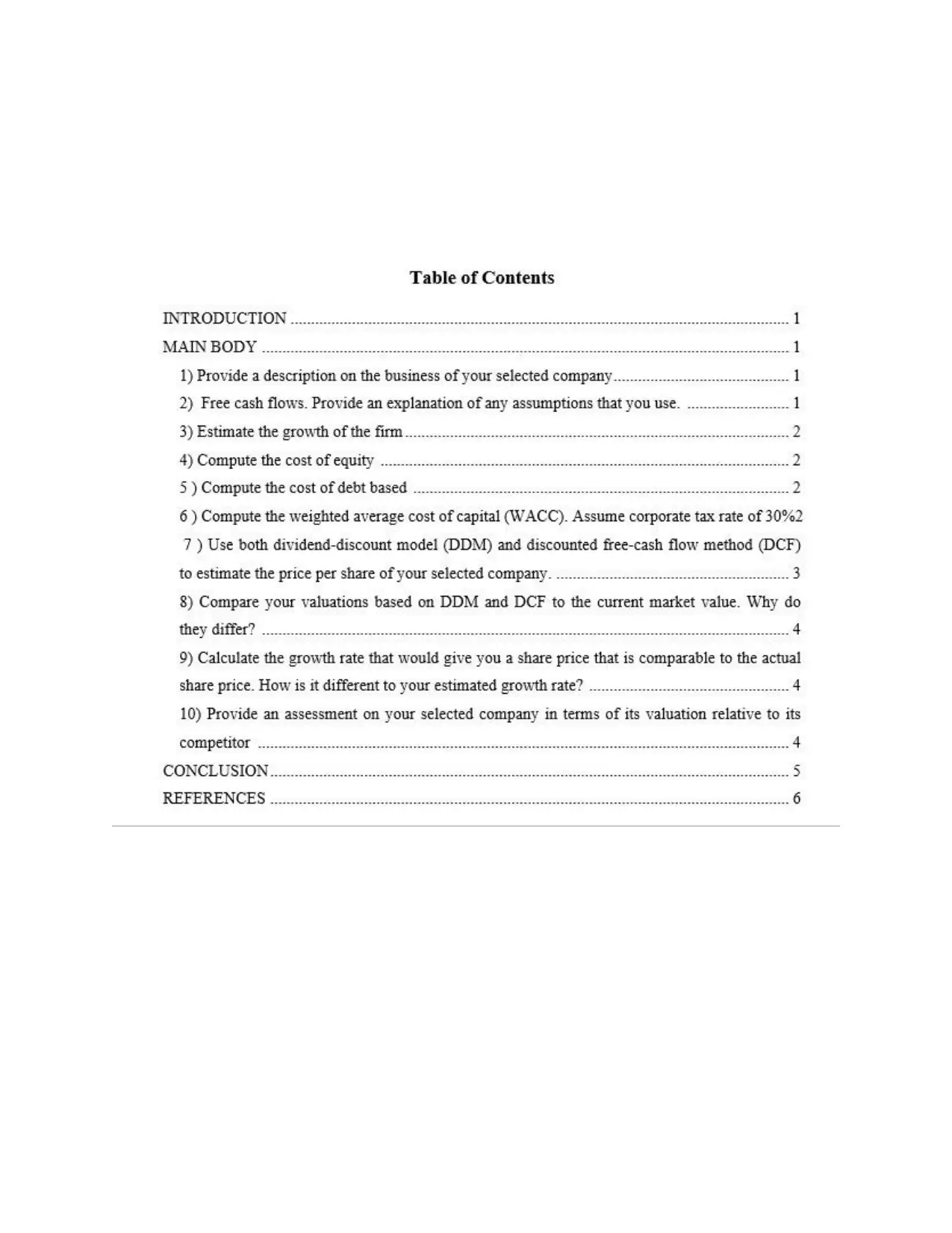
Paraphrase This Document
Need a fresh take? Get an instant paraphrase of this document with our AI Paraphraser
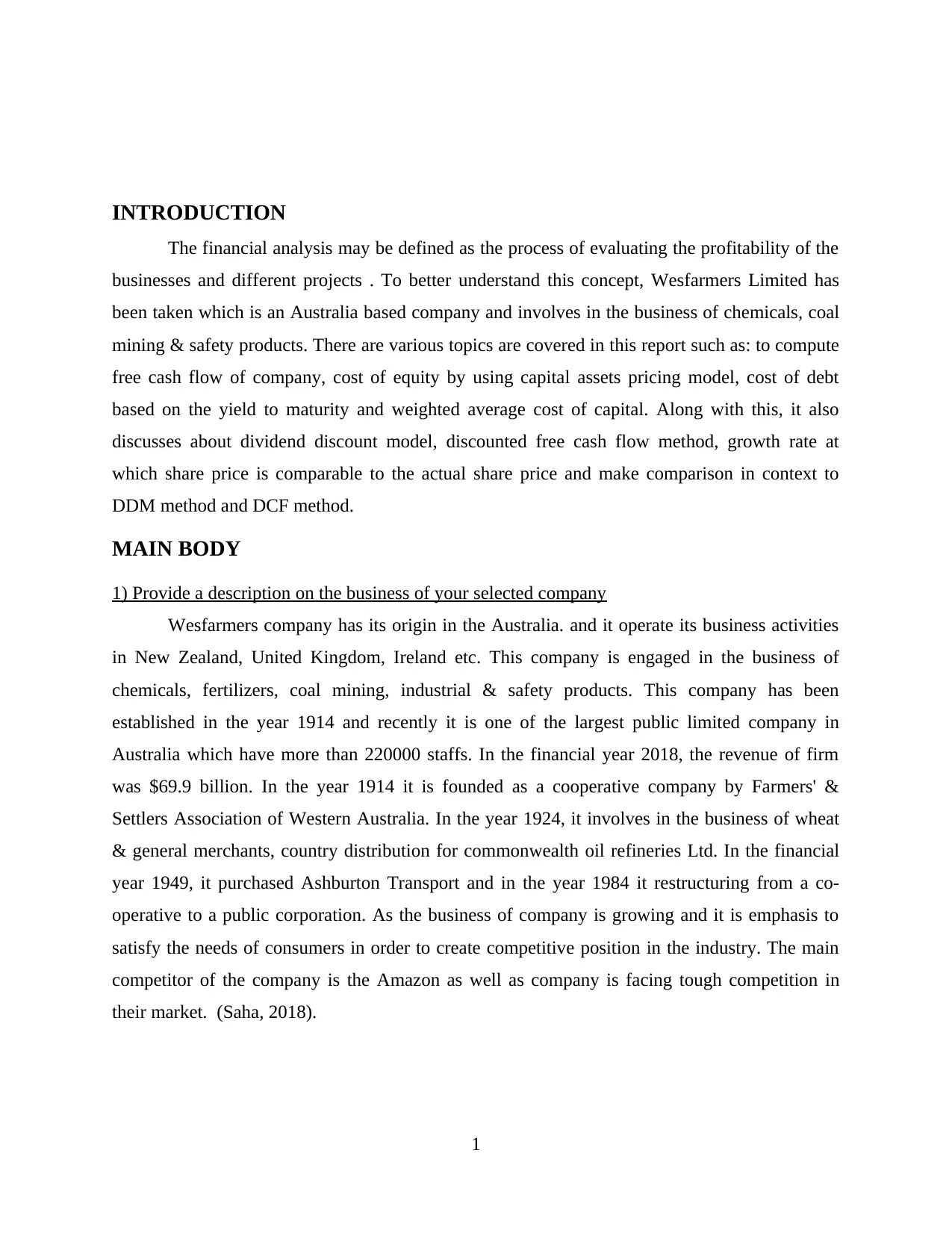
INTRODUCTION
The financial analysis may be defined as the process of evaluating the profitability of the
businesses and different projects . To better understand this concept, Wesfarmers Limited has
been taken which is an Australia based company and involves in the business of chemicals, coal
mining & safety products. There are various topics are covered in this report such as: to compute
free cash flow of company, cost of equity by using capital assets pricing model, cost of debt
based on the yield to maturity and weighted average cost of capital. Along with this, it also
discusses about dividend discount model, discounted free cash flow method, growth rate at
which share price is comparable to the actual share price and make comparison in context to
DDM method and DCF method.
MAIN BODY
1) Provide a description on the business of your selected company
Wesfarmers company has its origin in the Australia. and it operate its business activities
in New Zealand, United Kingdom, Ireland etc. This company is engaged in the business of
chemicals, fertilizers, coal mining, industrial & safety products. This company has been
established in the year 1914 and recently it is one of the largest public limited company in
Australia which have more than 220000 staffs. In the financial year 2018, the revenue of firm
was $69.9 billion. In the year 1914 it is founded as a cooperative company by Farmers' &
Settlers Association of Western Australia. In the year 1924, it involves in the business of wheat
& general merchants, country distribution for commonwealth oil refineries Ltd. In the financial
year 1949, it purchased Ashburton Transport and in the year 1984 it restructuring from a co-
operative to a public corporation. As the business of company is growing and it is emphasis to
satisfy the needs of consumers in order to create competitive position in the industry. The main
competitor of the company is the Amazon as well as company is facing tough competition in
their market. (Saha, 2018).
1
The financial analysis may be defined as the process of evaluating the profitability of the
businesses and different projects . To better understand this concept, Wesfarmers Limited has
been taken which is an Australia based company and involves in the business of chemicals, coal
mining & safety products. There are various topics are covered in this report such as: to compute
free cash flow of company, cost of equity by using capital assets pricing model, cost of debt
based on the yield to maturity and weighted average cost of capital. Along with this, it also
discusses about dividend discount model, discounted free cash flow method, growth rate at
which share price is comparable to the actual share price and make comparison in context to
DDM method and DCF method.
MAIN BODY
1) Provide a description on the business of your selected company
Wesfarmers company has its origin in the Australia. and it operate its business activities
in New Zealand, United Kingdom, Ireland etc. This company is engaged in the business of
chemicals, fertilizers, coal mining, industrial & safety products. This company has been
established in the year 1914 and recently it is one of the largest public limited company in
Australia which have more than 220000 staffs. In the financial year 2018, the revenue of firm
was $69.9 billion. In the year 1914 it is founded as a cooperative company by Farmers' &
Settlers Association of Western Australia. In the year 1924, it involves in the business of wheat
& general merchants, country distribution for commonwealth oil refineries Ltd. In the financial
year 1949, it purchased Ashburton Transport and in the year 1984 it restructuring from a co-
operative to a public corporation. As the business of company is growing and it is emphasis to
satisfy the needs of consumers in order to create competitive position in the industry. The main
competitor of the company is the Amazon as well as company is facing tough competition in
their market. (Saha, 2018).
1
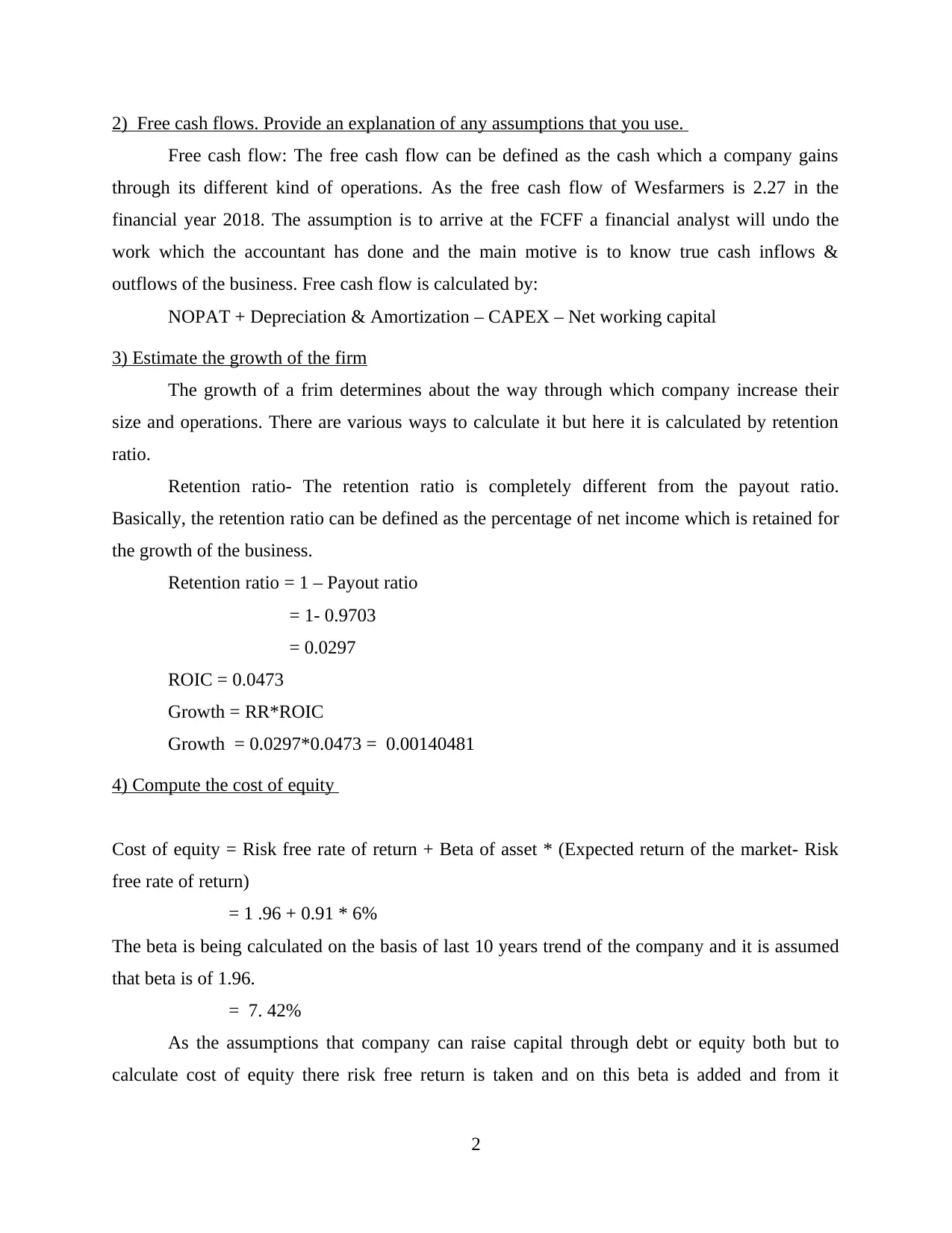
2) Free cash flows. Provide an explanation of any assumptions that you use.
Free cash flow: The free cash flow can be defined as the cash which a company gains
through its different kind of operations. As the free cash flow of Wesfarmers is 2.27 in the
financial year 2018. The assumption is to arrive at the FCFF a financial analyst will undo the
work which the accountant has done and the main motive is to know true cash inflows &
outflows of the business. Free cash flow is calculated by:
NOPAT + Depreciation & Amortization – CAPEX – Net working capital
3) Estimate the growth of the firm
The growth of a frim determines about the way through which company increase their
size and operations. There are various ways to calculate it but here it is calculated by retention
ratio.
Retention ratio- The retention ratio is completely different from the payout ratio.
Basically, the retention ratio can be defined as the percentage of net income which is retained for
the growth of the business.
Retention ratio = 1 – Payout ratio
= 1- 0.9703
= 0.0297
ROIC = 0.0473
Growth = RR*ROIC
Growth = 0.0297*0.0473 = 0.00140481
4) Compute the cost of equity
Cost of equity = Risk free rate of return + Beta of asset * (Expected return of the market- Risk
free rate of return)
= 1 .96 + 0.91 * 6%
The beta is being calculated on the basis of last 10 years trend of the company and it is assumed
that beta is of 1.96.
= 7. 42%
As the assumptions that company can raise capital through debt or equity both but to
calculate cost of equity there risk free return is taken and on this beta is added and from it
2
Free cash flow: The free cash flow can be defined as the cash which a company gains
through its different kind of operations. As the free cash flow of Wesfarmers is 2.27 in the
financial year 2018. The assumption is to arrive at the FCFF a financial analyst will undo the
work which the accountant has done and the main motive is to know true cash inflows &
outflows of the business. Free cash flow is calculated by:
NOPAT + Depreciation & Amortization – CAPEX – Net working capital
3) Estimate the growth of the firm
The growth of a frim determines about the way through which company increase their
size and operations. There are various ways to calculate it but here it is calculated by retention
ratio.
Retention ratio- The retention ratio is completely different from the payout ratio.
Basically, the retention ratio can be defined as the percentage of net income which is retained for
the growth of the business.
Retention ratio = 1 – Payout ratio
= 1- 0.9703
= 0.0297
ROIC = 0.0473
Growth = RR*ROIC
Growth = 0.0297*0.0473 = 0.00140481
4) Compute the cost of equity
Cost of equity = Risk free rate of return + Beta of asset * (Expected return of the market- Risk
free rate of return)
= 1 .96 + 0.91 * 6%
The beta is being calculated on the basis of last 10 years trend of the company and it is assumed
that beta is of 1.96.
= 7. 42%
As the assumptions that company can raise capital through debt or equity both but to
calculate cost of equity there risk free return is taken and on this beta is added and from it
2
⊘ This is a preview!⊘
Do you want full access?
Subscribe today to unlock all pages.

Trusted by 1+ million students worldwide
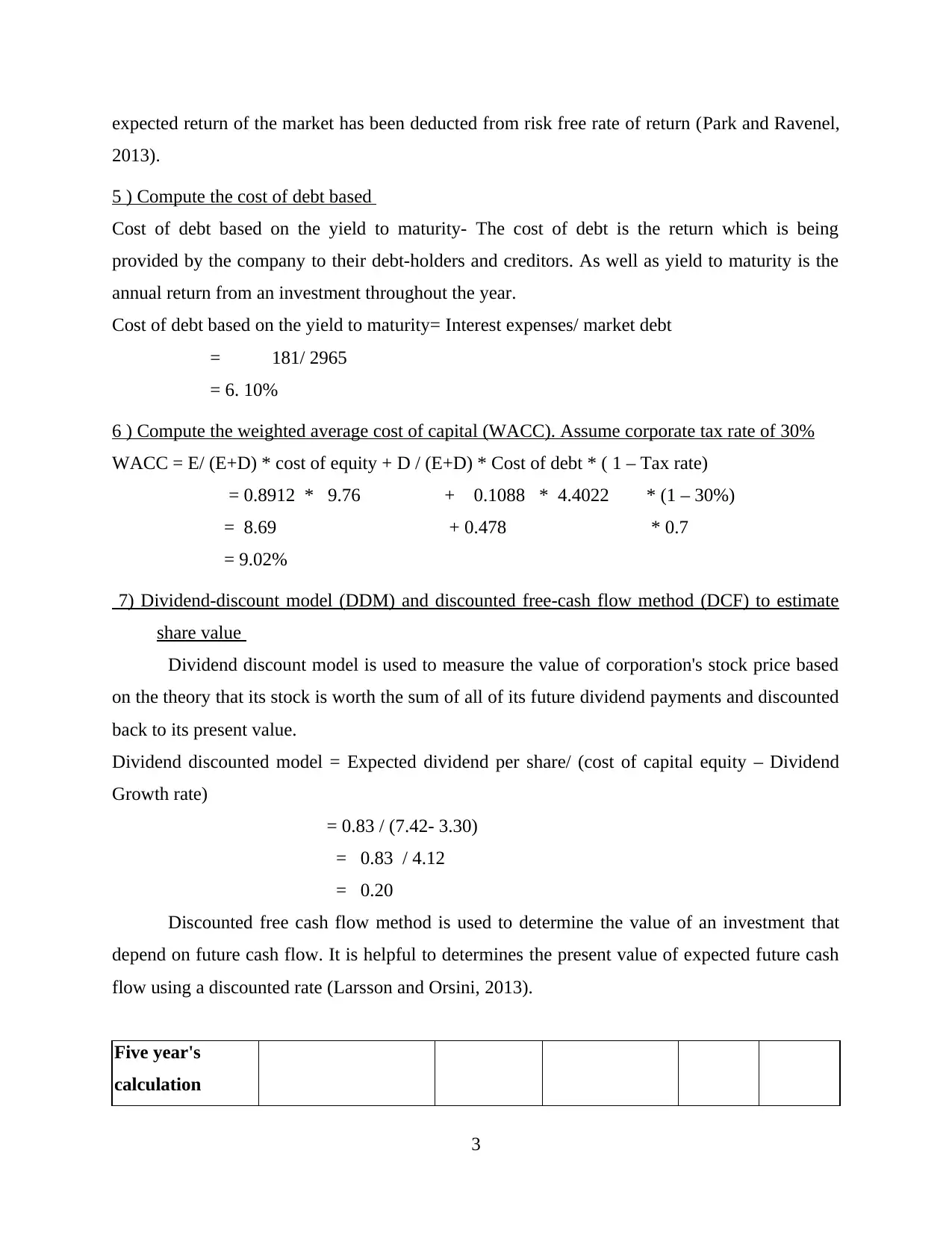
expected return of the market has been deducted from risk free rate of return (Park and Ravenel,
2013).
5 ) Compute the cost of debt based
Cost of debt based on the yield to maturity- The cost of debt is the return which is being
provided by the company to their debt-holders and creditors. As well as yield to maturity is the
annual return from an investment throughout the year.
Cost of debt based on the yield to maturity= Interest expenses/ market debt
= 181/ 2965
= 6. 10%
6 ) Compute the weighted average cost of capital (WACC). Assume corporate tax rate of 30%
WACC = E/ (E+D) * cost of equity + D / (E+D) * Cost of debt * ( 1 – Tax rate)
= 0.8912 * 9.76 + 0.1088 * 4.4022 * (1 – 30%)
= 8.69 + 0.478 * 0.7
= 9.02%
7) Dividend-discount model (DDM) and discounted free-cash flow method (DCF) to estimate
share value
Dividend discount model is used to measure the value of corporation's stock price based
on the theory that its stock is worth the sum of all of its future dividend payments and discounted
back to its present value.
Dividend discounted model = Expected dividend per share/ (cost of capital equity – Dividend
Growth rate)
= 0.83 / (7.42- 3.30)
= 0.83 / 4.12
= 0.20
Discounted free cash flow method is used to determine the value of an investment that
depend on future cash flow. It is helpful to determines the present value of expected future cash
flow using a discounted rate (Larsson and Orsini, 2013).
Five year's
calculation
3
2013).
5 ) Compute the cost of debt based
Cost of debt based on the yield to maturity- The cost of debt is the return which is being
provided by the company to their debt-holders and creditors. As well as yield to maturity is the
annual return from an investment throughout the year.
Cost of debt based on the yield to maturity= Interest expenses/ market debt
= 181/ 2965
= 6. 10%
6 ) Compute the weighted average cost of capital (WACC). Assume corporate tax rate of 30%
WACC = E/ (E+D) * cost of equity + D / (E+D) * Cost of debt * ( 1 – Tax rate)
= 0.8912 * 9.76 + 0.1088 * 4.4022 * (1 – 30%)
= 8.69 + 0.478 * 0.7
= 9.02%
7) Dividend-discount model (DDM) and discounted free-cash flow method (DCF) to estimate
share value
Dividend discount model is used to measure the value of corporation's stock price based
on the theory that its stock is worth the sum of all of its future dividend payments and discounted
back to its present value.
Dividend discounted model = Expected dividend per share/ (cost of capital equity – Dividend
Growth rate)
= 0.83 / (7.42- 3.30)
= 0.83 / 4.12
= 0.20
Discounted free cash flow method is used to determine the value of an investment that
depend on future cash flow. It is helpful to determines the present value of expected future cash
flow using a discounted rate (Larsson and Orsini, 2013).
Five year's
calculation
3
Paraphrase This Document
Need a fresh take? Get an instant paraphrase of this document with our AI Paraphraser
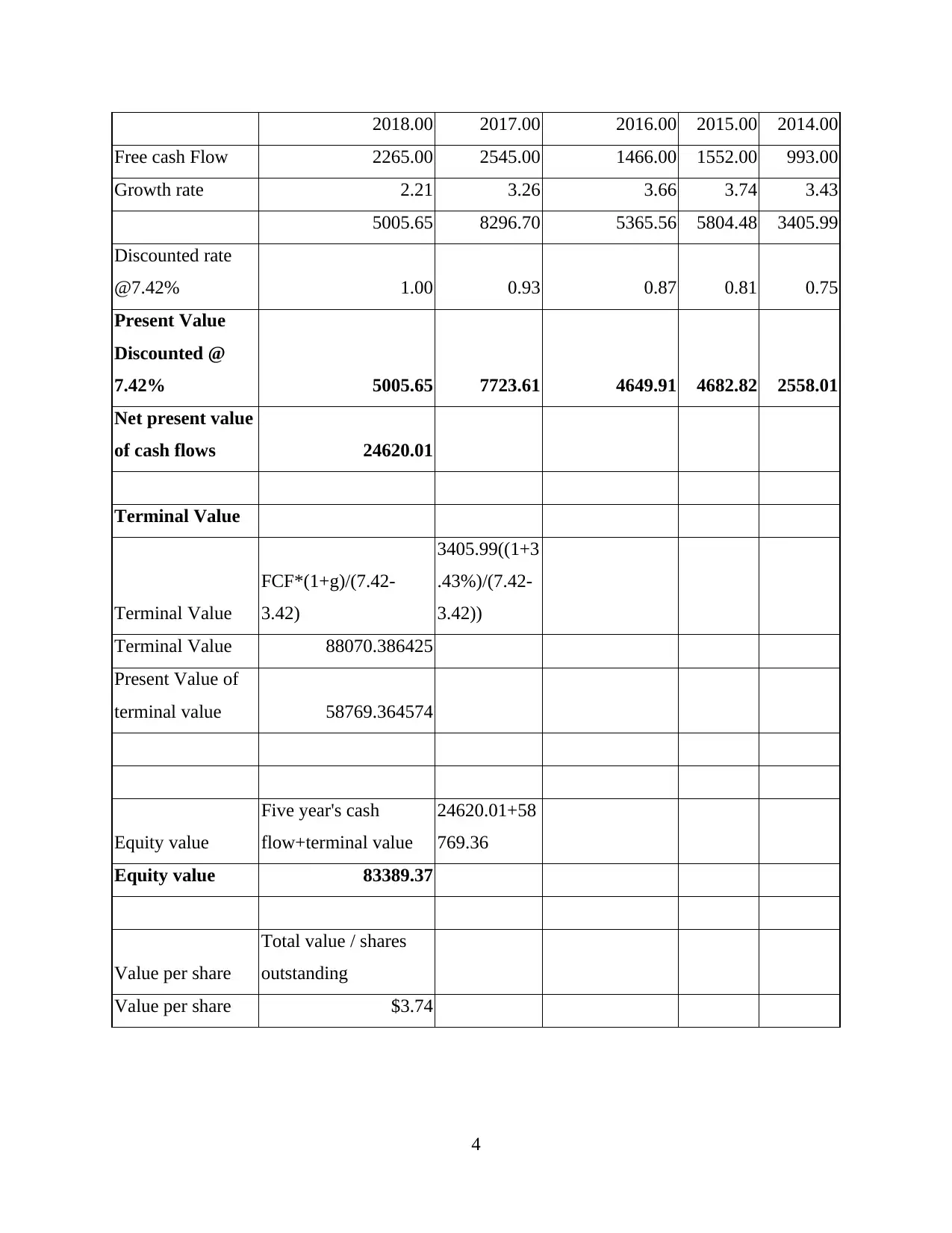
2018.00 2017.00 2016.00 2015.00 2014.00
Free cash Flow 2265.00 2545.00 1466.00 1552.00 993.00
Growth rate 2.21 3.26 3.66 3.74 3.43
5005.65 8296.70 5365.56 5804.48 3405.99
Discounted rate
@7.42% 1.00 0.93 0.87 0.81 0.75
Present Value
Discounted @
7.42% 5005.65 7723.61 4649.91 4682.82 2558.01
Net present value
of cash flows 24620.01
Terminal Value
Terminal Value
FCF*(1+g)/(7.42-
3.42)
3405.99((1+3
.43%)/(7.42-
3.42))
Terminal Value 88070.386425
Present Value of
terminal value 58769.364574
Equity value
Five year's cash
flow+terminal value
24620.01+58
769.36
Equity value 83389.37
Value per share
Total value / shares
outstanding
Value per share $3.74
4
Free cash Flow 2265.00 2545.00 1466.00 1552.00 993.00
Growth rate 2.21 3.26 3.66 3.74 3.43
5005.65 8296.70 5365.56 5804.48 3405.99
Discounted rate
@7.42% 1.00 0.93 0.87 0.81 0.75
Present Value
Discounted @
7.42% 5005.65 7723.61 4649.91 4682.82 2558.01
Net present value
of cash flows 24620.01
Terminal Value
Terminal Value
FCF*(1+g)/(7.42-
3.42)
3405.99((1+3
.43%)/(7.42-
3.42))
Terminal Value 88070.386425
Present Value of
terminal value 58769.364574
Equity value
Five year's cash
flow+terminal value
24620.01+58
769.36
Equity value 83389.37
Value per share
Total value / shares
outstanding
Value per share $3.74
4
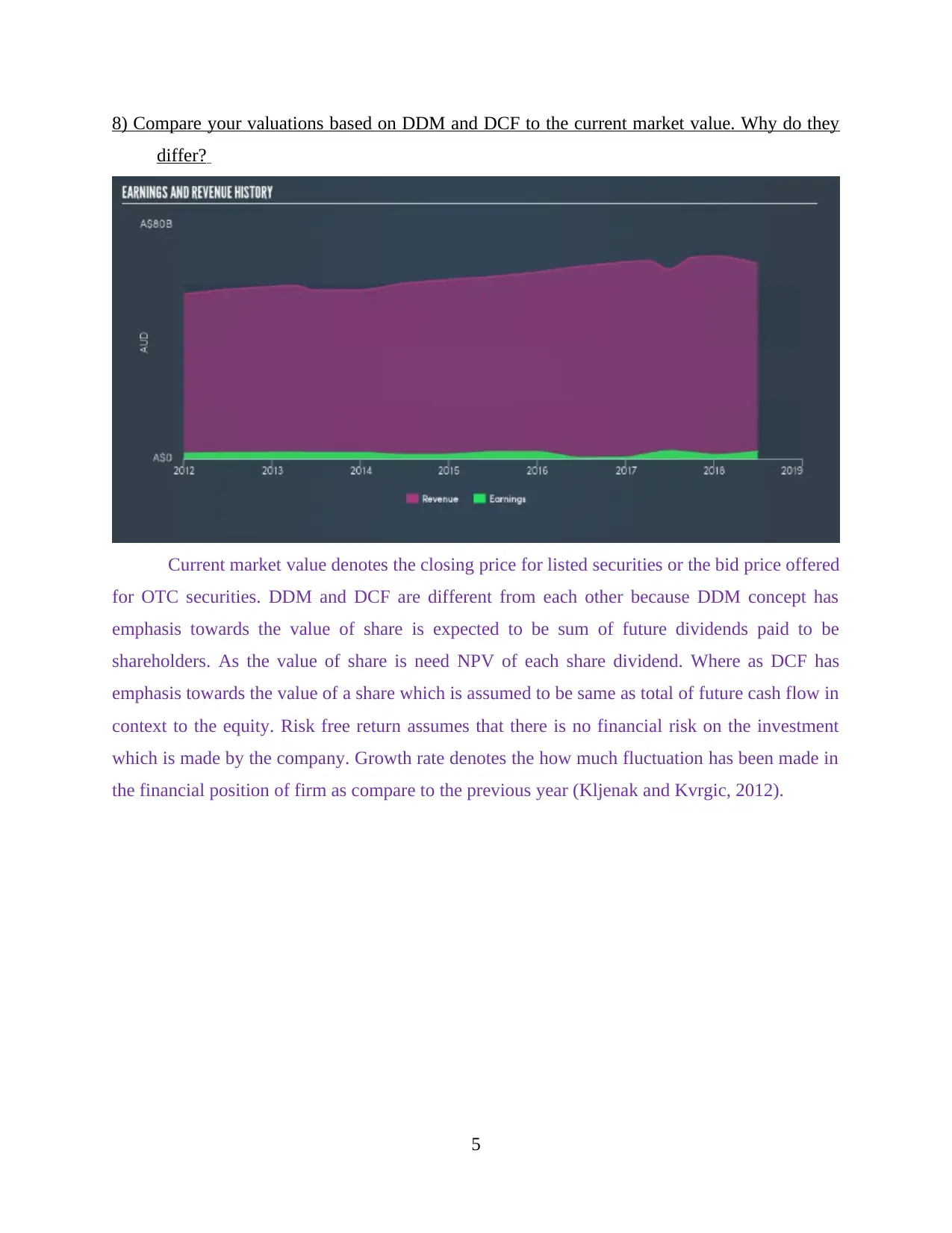
8) Compare your valuations based on DDM and DCF to the current market value. Why do they
differ?
Current market value denotes the closing price for listed securities or the bid price offered
for OTC securities. DDM and DCF are different from each other because DDM concept has
emphasis towards the value of share is expected to be sum of future dividends paid to be
shareholders. As the value of share is need NPV of each share dividend. Where as DCF has
emphasis towards the value of a share which is assumed to be same as total of future cash flow in
context to the equity. Risk free return assumes that there is no financial risk on the investment
which is made by the company. Growth rate denotes the how much fluctuation has been made in
the financial position of firm as compare to the previous year (Kljenak and Kvrgic, 2012).
5
differ?
Current market value denotes the closing price for listed securities or the bid price offered
for OTC securities. DDM and DCF are different from each other because DDM concept has
emphasis towards the value of share is expected to be sum of future dividends paid to be
shareholders. As the value of share is need NPV of each share dividend. Where as DCF has
emphasis towards the value of a share which is assumed to be same as total of future cash flow in
context to the equity. Risk free return assumes that there is no financial risk on the investment
which is made by the company. Growth rate denotes the how much fluctuation has been made in
the financial position of firm as compare to the previous year (Kljenak and Kvrgic, 2012).
5
⊘ This is a preview!⊘
Do you want full access?
Subscribe today to unlock all pages.

Trusted by 1+ million students worldwide
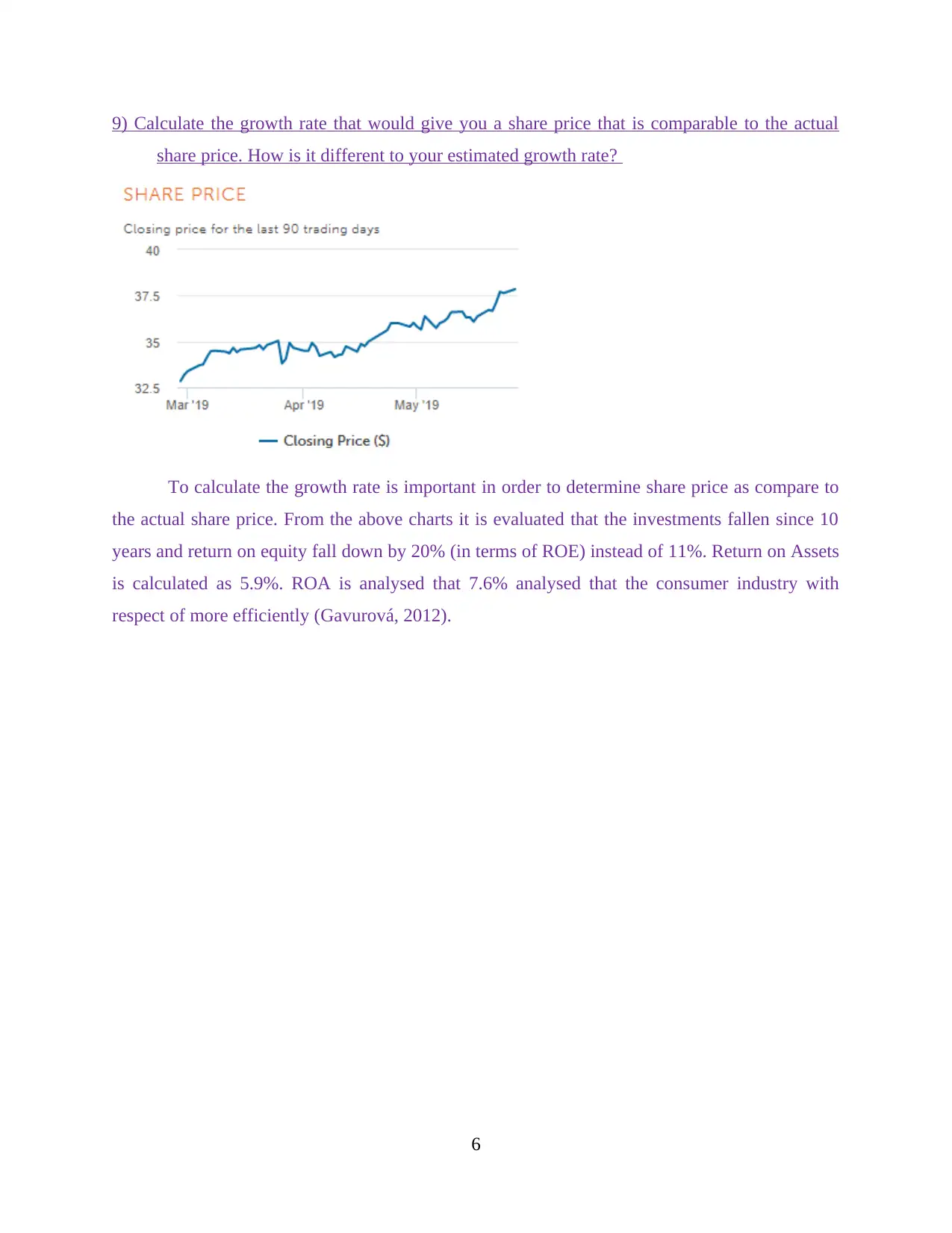
9) Calculate the growth rate that would give you a share price that is comparable to the actual
share price. How is it different to your estimated growth rate?
To calculate the growth rate is important in order to determine share price as compare to
the actual share price. From the above charts it is evaluated that the investments fallen since 10
years and return on equity fall down by 20% (in terms of ROE) instead of 11%. Return on Assets
is calculated as 5.9%. ROA is analysed that 7.6% analysed that the consumer industry with
respect of more efficiently (Gavurová, 2012).
6
share price. How is it different to your estimated growth rate?
To calculate the growth rate is important in order to determine share price as compare to
the actual share price. From the above charts it is evaluated that the investments fallen since 10
years and return on equity fall down by 20% (in terms of ROE) instead of 11%. Return on Assets
is calculated as 5.9%. ROA is analysed that 7.6% analysed that the consumer industry with
respect of more efficiently (Gavurová, 2012).
6
Paraphrase This Document
Need a fresh take? Get an instant paraphrase of this document with our AI Paraphraser

10) Provide an assessment on your selected company in terms of its valuation relative to its
competitor
Share market of Wesfarmers get impacted due to the business outlook and the
supermarket sector is analysed with in the diving deflation rates. Woolworth is one of the
nearest competitor that may impact the share market of Wesfarmers as the last year the
market of Woolwoths had a margin of 7.9% compared to 4.5% of Wesfarmers. Market cap
was recorded as $50524 million and equity shares was recorded as 1134 million. To make
comparison is important so that performance of an organisation can be determines. For that
purpose dividend discount model and discounted cash flow, method has been used. But it
is require to make comparison with the same industry. For the investors it is important to
take buying and selling decisions on the basis of financial performance, business growth,
price earning share and the market capitalization and total debt which a having by
company. Based on it investor can take the decision of buying and selling of shares
(Bloomberg, 2015).
7
competitor
Share market of Wesfarmers get impacted due to the business outlook and the
supermarket sector is analysed with in the diving deflation rates. Woolworth is one of the
nearest competitor that may impact the share market of Wesfarmers as the last year the
market of Woolwoths had a margin of 7.9% compared to 4.5% of Wesfarmers. Market cap
was recorded as $50524 million and equity shares was recorded as 1134 million. To make
comparison is important so that performance of an organisation can be determines. For that
purpose dividend discount model and discounted cash flow, method has been used. But it
is require to make comparison with the same industry. For the investors it is important to
take buying and selling decisions on the basis of financial performance, business growth,
price earning share and the market capitalization and total debt which a having by
company. Based on it investor can take the decision of buying and selling of shares
(Bloomberg, 2015).
7
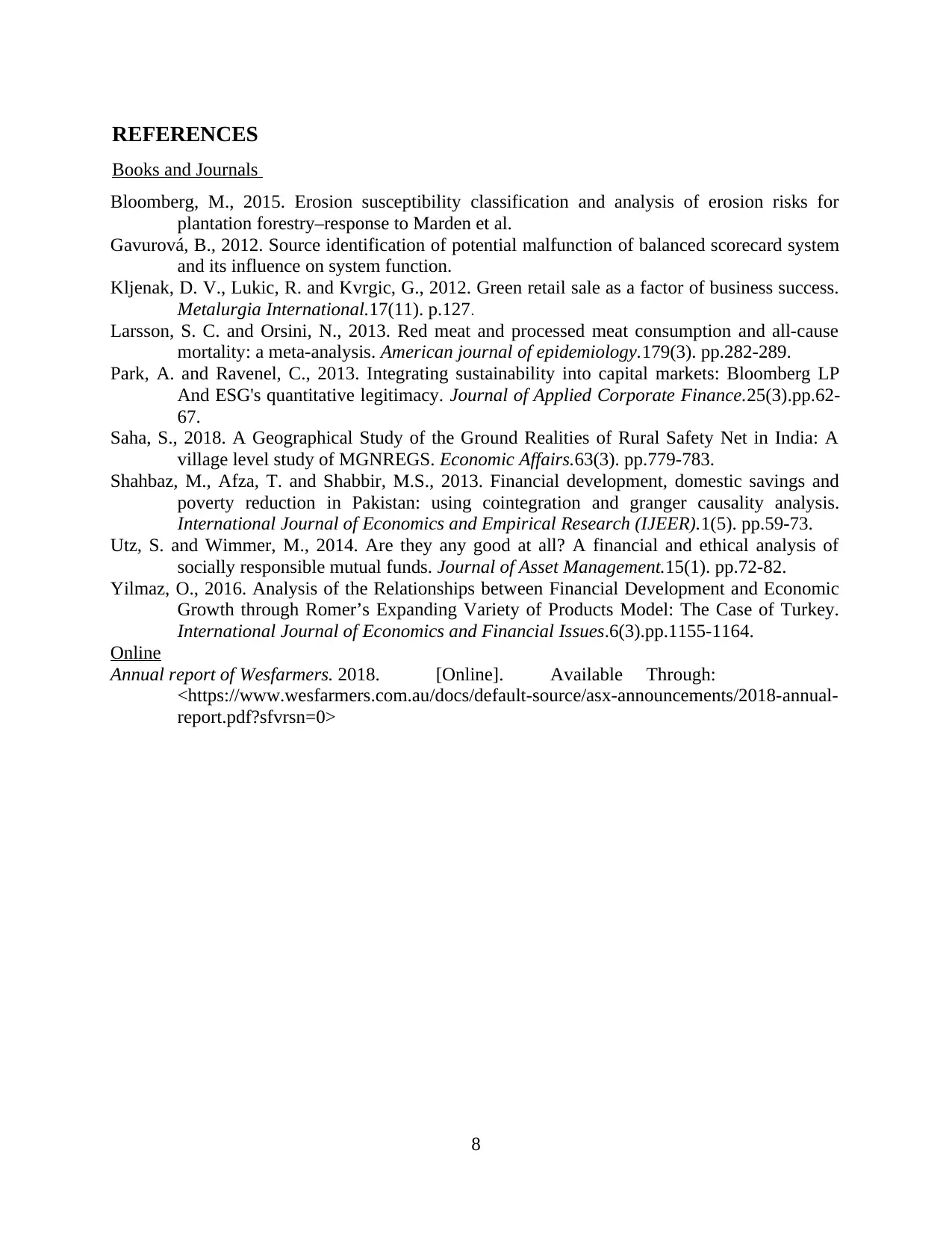
REFERENCES
Books and Journals
Bloomberg, M., 2015. Erosion susceptibility classification and analysis of erosion risks for
plantation forestry–response to Marden et al.
Gavurová, B., 2012. Source identification of potential malfunction of balanced scorecard system
and its influence on system function.
Kljenak, D. V., Lukic, R. and Kvrgic, G., 2012. Green retail sale as a factor of business success.
Metalurgia International.17(11). p.127.
Larsson, S. C. and Orsini, N., 2013. Red meat and processed meat consumption and all-cause
mortality: a meta-analysis. American journal of epidemiology.179(3). pp.282-289.
Park, A. and Ravenel, C., 2013. Integrating sustainability into capital markets: Bloomberg LP
And ESG's quantitative legitimacy. Journal of Applied Corporate Finance.25(3).pp.62-
67.
Saha, S., 2018. A Geographical Study of the Ground Realities of Rural Safety Net in India: A
village level study of MGNREGS. Economic Affairs.63(3). pp.779-783.
Shahbaz, M., Afza, T. and Shabbir, M.S., 2013. Financial development, domestic savings and
poverty reduction in Pakistan: using cointegration and granger causality analysis.
International Journal of Economics and Empirical Research (IJEER).1(5). pp.59-73.
Utz, S. and Wimmer, M., 2014. Are they any good at all? A financial and ethical analysis of
socially responsible mutual funds. Journal of Asset Management.15(1). pp.72-82.
Yilmaz, O., 2016. Analysis of the Relationships between Financial Development and Economic
Growth through Romer’s Expanding Variety of Products Model: The Case of Turkey.
International Journal of Economics and Financial Issues.6(3).pp.1155-1164.
Online
Annual report of Wesfarmers. 2018. [Online]. Available Through:
<https://www.wesfarmers.com.au/docs/default-source/asx-announcements/2018-annual-
report.pdf?sfvrsn=0>
8
Books and Journals
Bloomberg, M., 2015. Erosion susceptibility classification and analysis of erosion risks for
plantation forestry–response to Marden et al.
Gavurová, B., 2012. Source identification of potential malfunction of balanced scorecard system
and its influence on system function.
Kljenak, D. V., Lukic, R. and Kvrgic, G., 2012. Green retail sale as a factor of business success.
Metalurgia International.17(11). p.127.
Larsson, S. C. and Orsini, N., 2013. Red meat and processed meat consumption and all-cause
mortality: a meta-analysis. American journal of epidemiology.179(3). pp.282-289.
Park, A. and Ravenel, C., 2013. Integrating sustainability into capital markets: Bloomberg LP
And ESG's quantitative legitimacy. Journal of Applied Corporate Finance.25(3).pp.62-
67.
Saha, S., 2018. A Geographical Study of the Ground Realities of Rural Safety Net in India: A
village level study of MGNREGS. Economic Affairs.63(3). pp.779-783.
Shahbaz, M., Afza, T. and Shabbir, M.S., 2013. Financial development, domestic savings and
poverty reduction in Pakistan: using cointegration and granger causality analysis.
International Journal of Economics and Empirical Research (IJEER).1(5). pp.59-73.
Utz, S. and Wimmer, M., 2014. Are they any good at all? A financial and ethical analysis of
socially responsible mutual funds. Journal of Asset Management.15(1). pp.72-82.
Yilmaz, O., 2016. Analysis of the Relationships between Financial Development and Economic
Growth through Romer’s Expanding Variety of Products Model: The Case of Turkey.
International Journal of Economics and Financial Issues.6(3).pp.1155-1164.
Online
Annual report of Wesfarmers. 2018. [Online]. Available Through:
<https://www.wesfarmers.com.au/docs/default-source/asx-announcements/2018-annual-
report.pdf?sfvrsn=0>
8
⊘ This is a preview!⊘
Do you want full access?
Subscribe today to unlock all pages.

Trusted by 1+ million students worldwide
1 out of 9
Related Documents
Your All-in-One AI-Powered Toolkit for Academic Success.
+13062052269
info@desklib.com
Available 24*7 on WhatsApp / Email
![[object Object]](/_next/static/media/star-bottom.7253800d.svg)
Unlock your academic potential
Copyright © 2020–2025 A2Z Services. All Rights Reserved. Developed and managed by ZUCOL.





